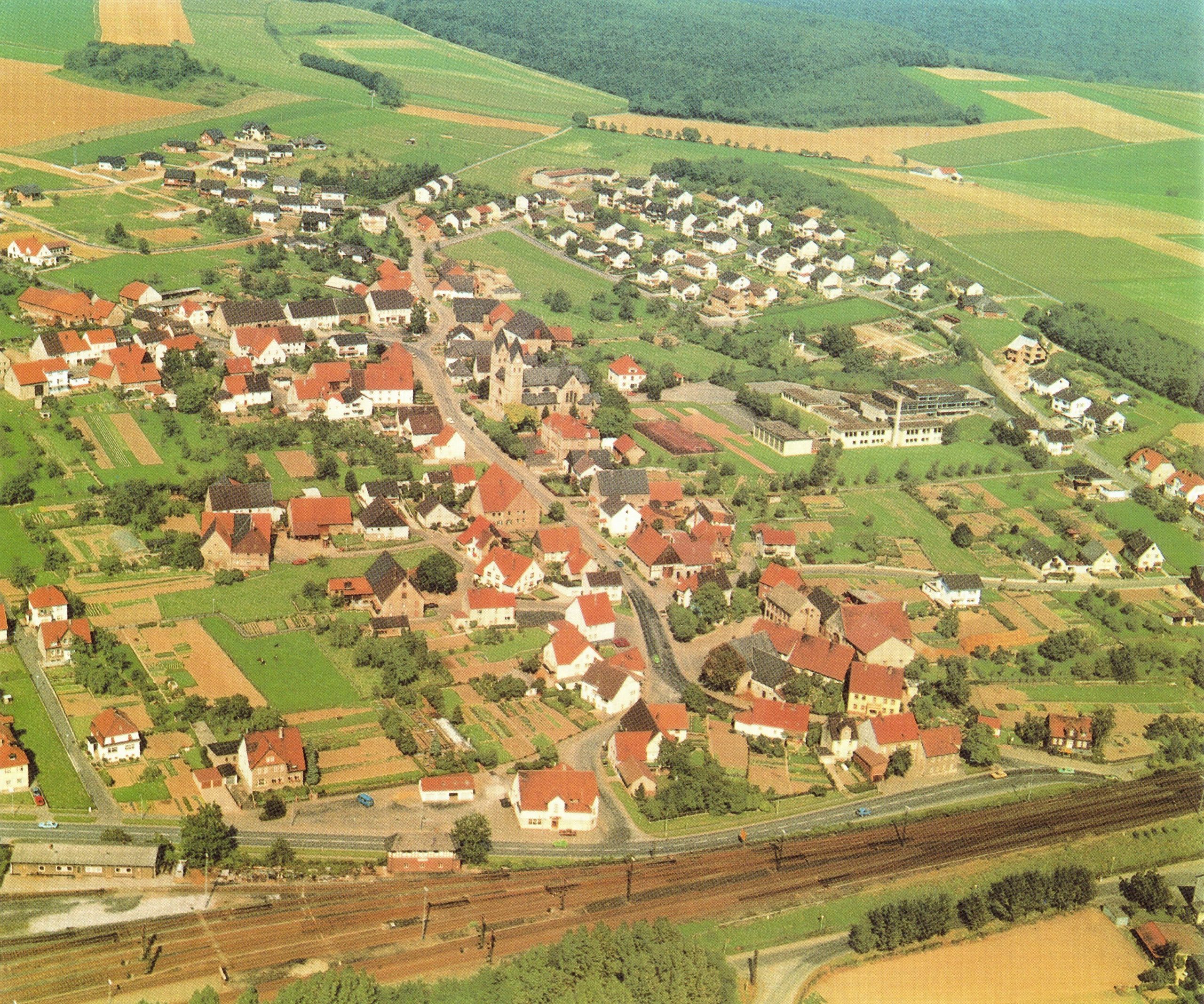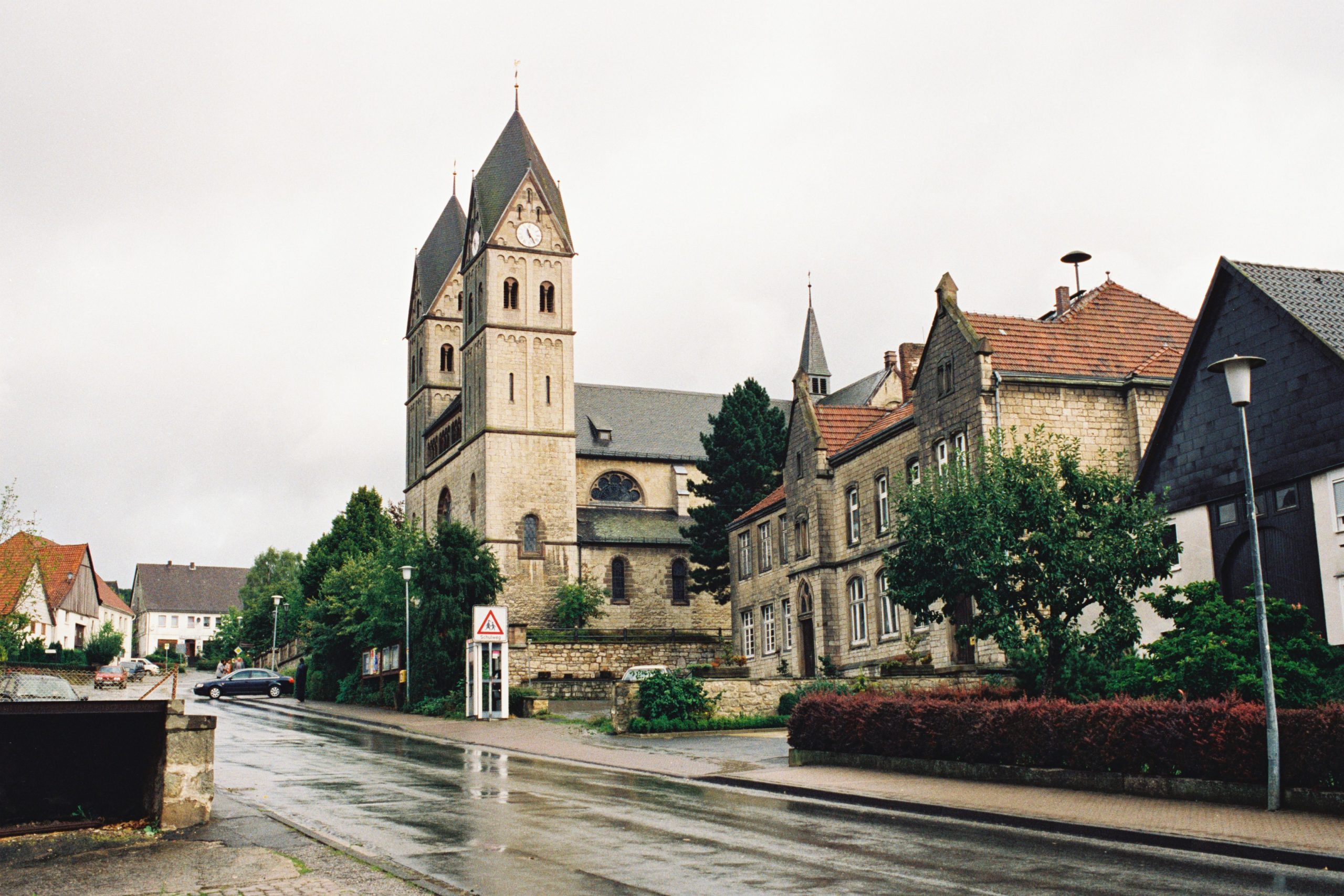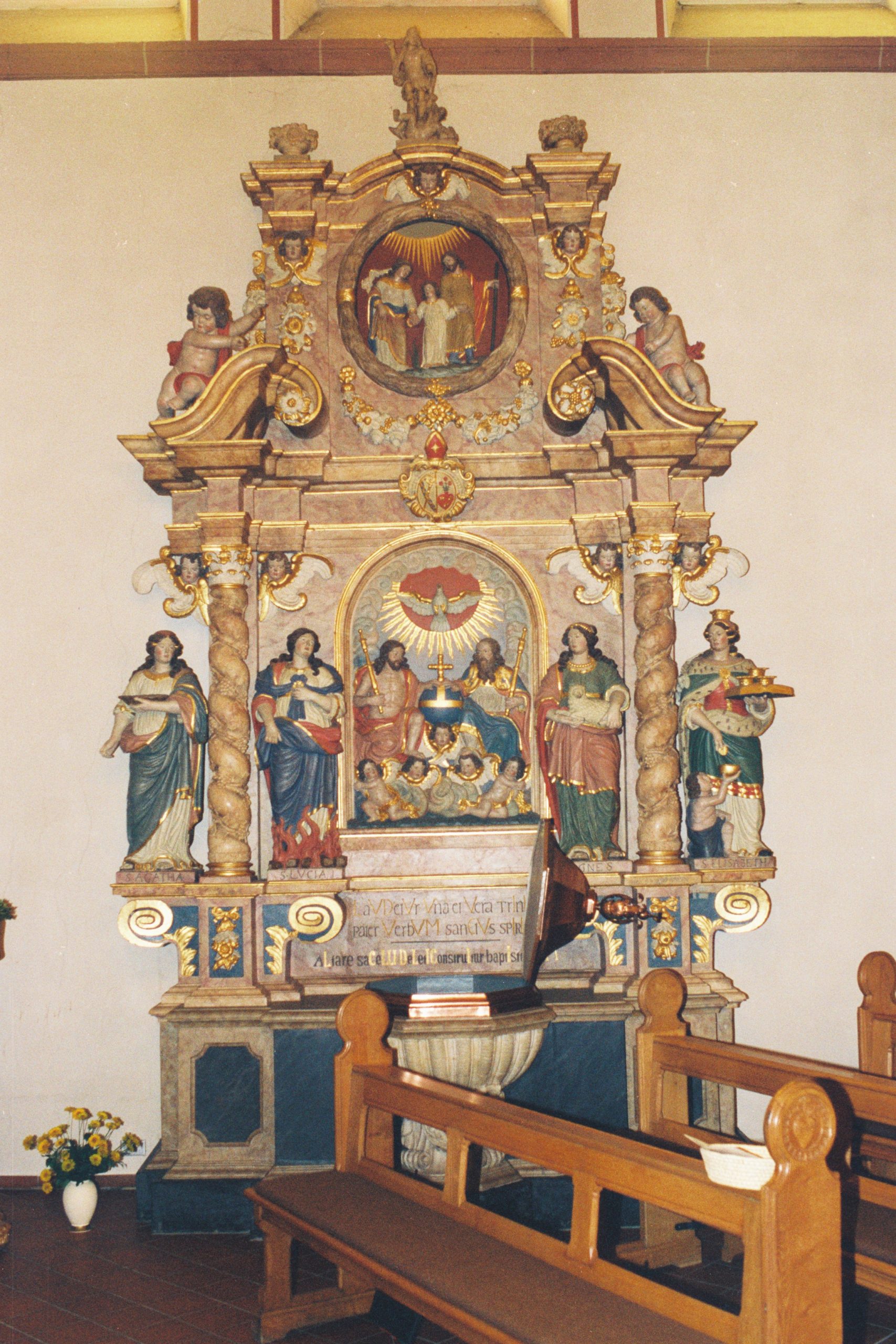The village of Rimbeck
A view of Rimbeck in 1992. It is situated in Diemeltal on Federal Highway 7. Rimbeck boasts a 1,100-year-old history. The church of St. Elisabeth is at the centre of the village, as is Overgaer Hauptschule (9-year elementary school). Pupils come to this school from Scherfede, Bonenburg, Ossendorf and Nörde. Besides small firms in the handicrafts field there is also a dairy here of supra-regional importance.
Rimbeck – general overview
Rimbeck, in Diemeltal at the southern edge of the Egge mountain range, eight kilometres north-west of the town of Warburg, a little less than two kilometres from Scherfede – the two villages practically merge – celebrated its 1100-year anniversary in 1983. The village, with a population of 1500 in 1994, was already mentioned in the ninth Century in the old Corvey property register. Rimbechi, Rymbeke, Rimbeke were old terms and mean “drainage stream”. Old documents relate about two little watercourses which in earlier times flowed open through the village and ran together into the Diemel.
When the Zisterzienser monastery was founded in Hardehausen in 1140, the monks acquired extensive property in Rimbeck too. In 1438 a monastery village was built in Rimbeck. Bit by bit the whole property in Rimbeck belonged to Hardehausen monastery, which secured the village with ditches, hedges and fences and set up village rules for Rimbeck around 1450. This “village law of Rimbeck”, which according to Professor Hallermann, from Münster, was unique in Westphalia, laid down the rights and duties of the inhabitants in 29 paragraphs; they were controlled by a mayor and a town council; at the time an exemplary regulation of self-administration. Generally speaking old sets of village rules from the Wesphalian area are not known. It can be supposed that in villages of the middle ages, law was based on old customs, earlier court rulings and decisions of the town councils; also in later times there would have been agreements between the landlords and the inhabitants of the villages or the landlords and the monasteries declared the law unilaterally.
The village law of Rimbeck from 1501 – the first version from 1450 was mislaid – with its 29 paragraphs was something special. It was also a unilateral statute the monastery in Hardehausen gave to the village of Rimbeck. Rimbeck alone among the monastery villages Scherfede, Bonenburg and Norde had a set of village rules. It is not known if these village rules also applied analogously for tha?e other monastery villages. Indeed these villages did have a council – possibly at a later time – like Rimbeck according to number 7 of the village rules. It is also conceivable that the association of Warburg from the old town and the new town in the so-called “big letter” of 1436 was an example of providing a legal basis in village law also in Rimbeck. Scherfede was almost totally destroyed in 1436 whereas Rimbeck was apparently spared from the troubles of the time. Number 7 stipulated that besides the chairman of the parish council called mayor here, there were also three councillors who were elected every year with the mayor (see also the section: Warburg “Functions and significance of the council”).
In the village law the tasks and duties of the population are regulated in the same way as the rights of the judge and mayor. Also details were subject to regulation, e.g. observance of the cultivation borders in the case of tilled land, sale of the house or also cleaning of the water drainage ditches on particular days. Of course the payment of fees is also regulated and penalties are laid down in the event of a lapse on the part of the villager. The wording of a short paragraph in the standard German of the time follows:
“Item we dar wont, schall redeliken leven und neimant schall den andern schedigen mit worden edder werken, noch gewalt an enne stellen bi bescreven rechten.”
St.-Elisabeth parish church in Rimbeck
An old chapel in Rimbeck, which was dedicated to St. Elisabeth, was demolished in 1904. When it was built has not yet been established; however it is recorded that it was renovated in 1613 under the Hardehausen Abbot Jacobus. The chapel was a massive building with a saddleback roof and a ridge turret and had two-bay cross-vaulting as well as on the north and south sides high round arched windows. It stood on the square in the centre of the village where the parish church of St. Elisabeth is today, on Elisabeth-Straße, at the corner of Wilhelm-Poth-Straße. There was a valuable baroque altar in the old chapel which is now in the right side-aisle of St. Elisabeth parish church finished in 1907, with two towers built in the Neo-Roman style.
The Trinity altar made of marble and alabaster from 1694 is the work of the baroque artist Heinrich Pape from Giershagen and shows over the central picture the coat of arms of Stephan Overgar (1675 to 1713) the important Abbot of the monastery of Hardehausen.
Worth seeing in the parish church are also an alabaster relief with Joachim and Anna, a relief with Our Lady and St. Bernhard as well as a confessional from 1772. These works of art as well as several pillars and shrines came from the earlier monastic church in Hardehausen demolished after secularisation.
In the right aisle of Rimbeck church: impressive, made of marble and alabaster, Trinity altar from the workshop of Heinrich Pape, the famous baroque artist from Giershagen, – was earlier the main altar of the old Rimbeck chapel – above the centre picture the coat of arms of Stephan Overgar (1675 – 1713) the important Abbot in Hardehausen.
Rimbeck always belonged to the parish of Scherfede. The abbots of Hardehausen had the right to determine a parson for Scherfede. As a rule monk-priests were chosen who then lived in Scherfede and had to take care of Rimbeck and Bonenburg.
Towards the end of the 17th Century after the terrible events of the Thirty Years War and the removal of the rubble, normality returned to Rimbeck and Hardehausen, indeed even to a new blooming, especially of Hardehausen monastery, from which the monastic village of Rimbeck also benefited. This improvement for the better is certainly due to the capable Abbot Stephan Overgar (1675 to 1713), who re-established the internal order in the monastery and by clever budgeting got funds for extensive renovation and construction in Hardehausen and in the monastic villages. In 1694 he had the well-known Zehntscheune in Scherfede built and Rimbeck chapel renovated. In 1694 by his order the altar of the Trinity made of alabaster and moiré Adorf marble was made by Heinrich Pape the baroque sculptor from Giershagen. Today this is still a great credit to St. Elisabeth church in Rimbeck.
The efforts of Rimbeck to sever links with the church administration in Scherfede and to establish an independent parish, received a new push in 1898 when the position in the chapel in Rimbeck was entrusted to curate Wilhelm Poth. According to the parish chronicles, he was sent to Rimbeck to “help ensure that the building of the church would soon be started”. It was possible to achieve that aim because almost the whole parish stood behind the project and were prepared to make their own unusual contribution with donations and unpaid manual work and unpaid horse and cart work. According to the chronicles the biggest contribution was made by Miss Maria Laudage, called Wilms; she gave her whole fortune as a present with more than 100 Morgen (acres) of land (1 acre = 0,25 ha) to set up a benefice. The church was finished and consecrated in 1907.


